文章目录
- 1.创建数据库访问接口
- 2.创建第一个对应接口--学校数据访问接口
- 3.创建第二个对应接口--状态数据访问接口
- 4.创建第三个对应接口--学生数据访问接口
- 5.创建第四个对应访问接口--用户数据访问接口
- 6.创建数据访问接口实现类
- 7.创建学校数据访问接口实现类
- 8.单元测试:对CollegeDaoImpl进行单元测试
- 9.创建状态数据访问接口实现类
- 10.对StatusDaoImpl进行单元测试
- 11.编写testUpdate方法
- 12.学生数据访问接口实现类
- 13.对StudentDaoImpl进行单元测试
-
- (1) 编写testInsert方法
- (2)编写testDeleteById()方法
- (3)编写testDeleteByClass()方法
- (4)编写testFindByName()方法
- (5)编写testFindAll()方法
- (6)编写testFindRowsBySex()方法
- (7) 编写testDeleteByDepartment()方法
- (8)编写testUpdate()方法
- (9)编写testFindById()方法
- (10)编写testFindByClass()方法
- (11)编写testFindByDepartment()方法
- (12)编写testFindRowsByClass()方法
- (13)编写testFindRowsByDepartment()方法
- 14.创建用户数据访问接口实现类
- 15.单元测试:对UserDaoImpl进行单元测试
- 总结
1.创建数据库访问接口
在net.lyq.student包中创建如下图所示的包–bao,用来存放数据库的对应接口。
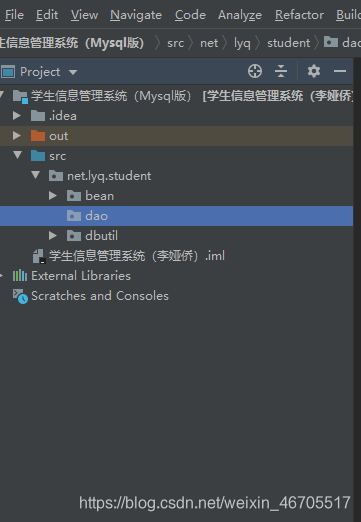
2.创建第一个对应接口–学校数据访问接口
创建bean目录下College类所对应的接口CollegeDao.

详细代码如下:

3.创建第二个对应接口–状态数据访问接口
创建状态数据访问接口:

接口详细代码如下:

4.创建第三个对应接口–学生数据访问接口

详细代码如下:

5.创建第四个对应访问接口–用户数据访问接口

详细代码为:

6.创建数据访问接口实现类
在dao包中创建子包impl

7.创建学校数据访问接口实现类

下面展示一些 内联代码片。
package net.lyq.student.dao.impl;
import net.lyq.student.bean.College;
import net.lyq.student.dao.CollegeDao;
import net.lyq.student.dbutil.ConnectionManager;
import java.sql.*;
public class CollegeDaoImpl implements CollegeDao {
@Override
public College findById(int id) {
College college = null;
//获取数据库连接
Connection conn = ConnectionManager.getConnection();
//定义SQL字符
String strSQL = "select * from t_college where id = ?";
try {
PreparedStatement pstmt = conn.prepareStatement(strSQL);
pstmt.setInt(1,id);
ResultSet rs = pstmt.executeQuery();
if(rs.next()){
college.setId(rs.getInt("id"));
college.setName(rs.getString("name"));
college.setPresident(rs.getString("president"));
college.setStartTime(rs.getTimestamp("start_time"));
college.setTelephone(rs.getString("telephone"));
college.setEmail(rs.getString("email"));
college.setAddress(rs.getString("address"));
college.setProfile(rs.getString("profile"));
}
//关闭预备语句对象
pstmt.close();
//关闭结果集对象
rs.close();
} catch (SQLException throwables) {
throwables.printStackTrace();
} finally {
//关闭连接
ConnectionManager.closeConnection(conn);
}
//返回学校对象
return college;
}
@Override
public int update(College college) {
//定义更新记录数
int count = 0;
//获取数据库连接
Connection conn = ConnectionManager.getConnection();
//定义SQL字符串
String strSQL = "update t_college set name = ? ,president = ? ,start_time = ? "
+ "teltphone = ? ,email = ? , adress = ?, profile = ? where id = ?";
try {
//设置占位符的值
PreparedStatement pstmt = conn.prepareStatement(strSQL);
pstmt.setString(1,college.getName());
pstmt.setString(2,college.getPresident());
pstmt.setTimestamp(3,new Timestamp( college.getStartTime().getTime()));
pstmt.setString(4,college.getTelephone());
pstmt.setString(5,college.getEmail());
pstmt.setString(6,college.getAddress());
pstmt.setString(7, college.getProfile());
pstmt.setInt(8,college.getId());
//执行SQL,返回更新记录数
count = pstmt.executeUpdate();
pstmt.close();
} catch (SQLException throwables) {
throwables.printStackTrace();
} finally {
ConnectionManager.closeConnection(conn);
}
return count;
}
}
8.单元测试:对CollegeDaoImpl进行单元测试

下面展示一些 内联代码片。
package net.lyq.student.test;
import net.lyq.student.bean.College;
import net.lyq.student.dao.CollegeDao;
import net.lyq.student.dao.impl.CollegeDaoImpl;
import org.junit.Test;
public class TestCollegeDaoImpl {
@Test
public void testFindById(){
//创建学校接口类访问接口对象
CollegeDao dao = new CollegeDaoImpl();
//调用学校数据访问对象的查找方法,获取学校对象
College college = dao.findById(1);
//输出学校信息
System.out.println("校名:"+college.getName());
System.out.println("校长:"+college.getPresident());
System.out.println("地址:"+college.getAddress());
System.out.println("邮箱:"+college.getEmail());
System.out.println("电话:"+college.getTelephone());
}
@Test
public void testUpdate(){
CollegeDao dao = new CollegeDaoImpl();
College college = dao.findById(1);
college.setPresident("王洪礼");
int count = dao.update(college);
if (count > 0){
System.out.println("学校记录更新成功!!!");
System.out.println("新校长"+dao.findById(1).getPresident());
}else{
System.out.println("学校记录更新失败!!");
}
}
}
在此代码中包含两个单元测试方法testFindById(),testUpdate(),添加测试注解符@test,如需使用@test注解方法,需要使用JUnit4,讲@test添加进入JUnit4的类路径
由于两种测试方法的第一行代码相同,则可以提取出来,放在两种测试方法的外层。
在每个单元测试之前都要执行的代码,我们可以将代码放在一个方法里面,但是加上一个注解符@Before即可。
在每个单元测试之后都要执行的代码,我们可以将代码放在一个方法里面,但是加上一个注解符@After即可。
9.创建状态数据访问接口实现类
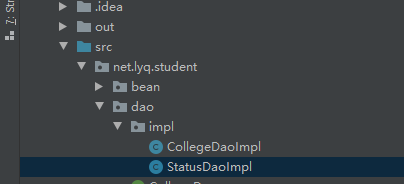
下面展示一些 内联代码片。
package net.lyq.student.dao.impl;
import net.lyq.student.bean.Status;
import net.lyq.student.dao.StatusDao;
import net.lyq.student.dbutil.ConnectionManager;
import java.sql.Connection;
import java.sql.PreparedStatement;
import java.sql.ResultSet;
import java.sql.SQLException;
public class StatusDaoImpl implements StatusDao {
@Override
public Status findById(int id) {
// 声明状态对象
Status status = null;
// 1. 获取数据库连接对象
Connection conn = ConnectionManager.getConnection();
// 2. 定义SQL字符串
String strSQL = "SELECT * FROM t_status WHERE id = ?";
try {
// 3. 创建预备语句对象
PreparedStatement pstmt = conn.prepareStatement(strSQL);
// 4. 设置占位符的值
pstmt.setInt(1, id);
// 5. 执行SQL查询,返回结果集
ResultSet rs = pstmt.executeQuery();
// 6. 判断结果集是否有记录
if (rs.next()) {
// 实例化状态
status = new Status();
// 利用当前记录字段值去设置状态对象的属性
status.setId(rs.getInt("id"));
status.setCollege(rs.getString("college"));
status.setVersion(rs.getString("version"));
status.setAuthor(rs.getString("author"));
status.setTelephone(rs.getString("telephone"));
status.setAddress(rs.getString("address"));
status.setEmail(rs.getString("email"));
}
// 7. 关闭预备语句对象
pstmt.close();
// 8. 关闭结果集对象
rs.close();
} catch (SQLException e) {
e.printStackTrace();
} finally {
// 关闭数据库连接
ConnectionManager.closeConnection(conn);
}
// 返回状态对象
return status;
}
@Override
public int update(Status status) {
// 定义更新记录数
int count = 0;
// 1. 获得数据库连接
Connection conn = ConnectionManager.getConnection();
// 2. 定义SQL字符串
String strSQL = "update t_status set college = ?, version = ?, author = ?,"
+ " telephone = ?, address = ?, email = ? where id = ?";
try {
// 3. 创建预备语句对象
PreparedStatement pstmt = conn.prepareStatement(strSQL);
// 4. 设置占位符的值
pstmt.setString(1, status.getCollege());
pstmt.setString(2, status.getVersion());
pstmt.setString(3, status.getAuthor());
pstmt.setString(4, status.getTelephone());
pstmt.setString(5, status.getAddress());
pstmt.setString(6, status.getEmail());
pstmt.setInt(7, status.getId());
// 5. 执行更新操作,更新记录
count = pstmt.executeUpdate();
// 6. 关闭预备语句对象
pstmt.close();
} catch (SQLException e) {
e.printStackTrace();
} finally {
// 关闭数据库连接
ConnectionManager.closeConnection(conn);
}
// 返回更新记录数
return count;
}
}
====
10.对StatusDaoImpl进行单元测试
在test包下建立测试类

下面展示一些 内联代码片。
package net.lyq.student.test;
import net.lyq.student.bean.Status;
import net.lyq.student.dao.StatusDao;
import net.lyq.student.dao.impl.StatusDaoImpl;
import org.junit.Test;
public class TestStatusDaoImpl {
StatusDao dao = new StatusDaoImpl();
@Test
public void testFindById(){
Status status = dao.findById(1);
System.out.println("作者:"+status.getAuthor());
System.out.println("学校:"+status.getCollege());
System.out.println("版本:"+status.getVersion());
System.out.println("地址:"+status.getAddress());
System.out.println("电话:"+status.getTelephone());
System.out.println("邮箱:"+status.getEmail());
}
}
11.编写testUpdate方法

运行结果:

12.学生数据访问接口实现类

下面展示一些 内联代码片。
package net.lyq.student.dao.impl;
import net.lyq.student.bean.Student;
import net.lyq.student.dao.StudentDao;
import net.lyq.student.dbutil.ConnectionManager;
import java.sql.*;
import java.util.ArrayList;
import java.util.List;
import java.util.Vector;
public class StudentDaoImpl implements StudentDao {
@Override
public int insert(Student student) {
// 定义插入记录数
int count = 0;
// 1. 获得数据库连接
Connection conn = ConnectionManager.getConnection();
// 2. 定义SQL字符串
String strSQL = "insert into t_student (id, name, sex, age, department, class, telephone)"
+ " values (?, ?, ?, ?, ?, ?, ?)";
try {
// 3. 创建预备语句对象
PreparedStatement pstmt = conn.prepareStatement(strSQL);
// 4. 设置占位符的值
pstmt.setString(1, student.getId());
pstmt.setString(2, student.getName());
pstmt.setString(3, student.getSex());
pstmt.setInt(4, student.getAge());
pstmt.setString(5, student.getDepartment());
pstmt.setString(6, student.getClazz());
pstmt.setString(7, student.getTelephone());
// 5. 执行SQL,返回插入记录数
count = pstmt.executeUpdate();
// 6. 关闭预备语句对象
pstmt.close();
} catch (SQLException e) {
e.printStackTrace();
} finally {
// 关闭数据库连接
ConnectionManager.closeConnection(conn);
}
// 返回插入记录数
return count;
}
/**
* 按学号删除学生记录
*
* @param id
* @return 删除记录数
*/
@Override
public int deleteById(String id) {
// 定义删除记录数
int count = 0;
// 1. 获取数据库连接
Connection conn = ConnectionManager.getConnection();
// 2. 定义SQL字符串
String strSQL = "delete from t_student where id = ?";
try {
// 3. 创建预备语句对象
PreparedStatement pstmt = conn.prepareStatement(strSQL);
// 4. 设置占位符的值
pstmt.setString(1, id);
// 5. 执行SQL,返回删除记录数
count = pstmt.executeUpdate();
// 6. 关闭预备语句对象
pstmt.close();
} catch (SQLException e) {
e.printStackTrace();
} finally {
// 关闭数据库连接
ConnectionManager.closeConnection(conn);
}
// 返回删除记录数
return count;
}
/**
* 按班级删除学生记录
*
* @param clazz
* @return 删除记录数
*/
@Override
public int deleteByClass(String clazz) {
// 定义删除记录数
int count = 0;
// 1. 获取数据库连接
Connection conn = ConnectionManager.getConnection();
// 2. 定义SQL字符串
String strSQL = "delete from t_student where class = ?";
try {
// 3. 创建预备语句对象
PreparedStatement pstmt = conn.prepareStatement(strSQL);
// 4. 设置占位符的值
pstmt.setString(1, clazz);
// 5. 执行SQL,返回删除记录数
count = pstmt.executeUpdate();
// 6. 关闭预备语句对象
pstmt.close();
} catch (SQLException e) {
e.printStackTrace();
} finally {
// 关闭数据库连接
ConnectionManager.closeConnection(conn);
}
// 返回删除记录数
return count;
}
/**
* 按系部删除学生记录
*
* @param department
* @return 删除记录数
*/
@Override
public int deleteByDepartment(String department) {
// 定义删除记录数
int count = 0;
// 1. 获得数据库连接
Connection conn = ConnectionManager.getConnection();
// 2. 定义SQL字符串
String strSQL = "delete from t_student where department = ?";
try {
// 3. 创建预备语句对象
PreparedStatement pstmt = conn.prepareStatement(strSQL);
// 4. 设置占位符的值
pstmt.setString(1, department);
// 5. 执行SQL,返回删除记录数
count = pstmt.executeUpdate();
// 6. 关闭预备语句对象
pstmt.close();
} catch (SQLException e) {
e.printStackTrace();
} finally {
// 关闭数据库连接
ConnectionManager.closeConnection(conn);
}
// 返回删除记录数
return count;
}
/**
* 更新学生记录
*
* @param student
* @return 更新记录数
*/
@Override
public int update(Student student) {
// 定义更新记录数
int count = 0;
// 1. 获得数据库连接
Connection conn = ConnectionManager.getConnection();
// 2. 定义SQL字符串
String strSQL = "update t_student set name = ?, sex = ?, age = ?,"
+ " department = ?, class = ?, telephone = ? where id = ?";
try {
// 3. 创建预备语句对象
PreparedStatement pstmt = conn.prepareStatement(strSQL);
// 4. 设置占位符的值
pstmt.setString(1, student.getName());
pstmt.setString(2, student.getSex());
pstmt.setInt(3, student.getAge());
pstmt.setString(4, student.getDepartment());
pstmt.setString(5, student.getClazz());
pstmt.setString(6, student.getTelephone());
pstmt.setString(7, student.getId());
// 5. 执行SQL,返回更新记录数
count = pstmt.executeUpdate();
// 6. 关闭预备语句对象
pstmt.close();
} catch (SQLException e) {
e.printStackTrace();
} finally {
// 关闭数据库连接
ConnectionManager.closeConnection(conn);
}
// 返回更新记录数
return count;
}
/**
* 按学号查询学生记录
*
* @param id
* @return 学生实体
*/
@Override
public Student findById(String id) {
// 声明学生对象
Student student = null;
// 1. 获取数据库连接对象
Connection conn = ConnectionManager.getConnection();
// 2. 定义SQL字符串
String strSQL = "select * from t_student where id = ?";
try {
// 3. 创建预备语句对象
PreparedStatement pstmt = conn.prepareStatement(strSQL);
// 4. 设置占位符的值
pstmt.setString(1, id);
// 5. 执行SQL,返回结果集
ResultSet rs = pstmt.executeQuery();
// 6. 判断结果集是否有记录
if (rs.next()) {
// 创建学生实体
student = new Student();
// 利用当前记录各字段值设置学生实体属性
student.setId(rs.getString("id"));
student.setName(rs.getString("name"));
student.setSex(rs.getString("sex"));
student.setAge(rs.getInt("age"));
student.setDepartment(rs.getString("department"));
student.setClazz(rs.getString("class"));
student.setTelephone(rs.getString("telephone"));
}
} catch (SQLException e) {
e.printStackTrace();
} finally {
// 关闭数据库连接
ConnectionManager.closeConnection(conn);
}
// 返回学生对象
return student;
}
/**
* 按姓名查询学生记录
*
* @param name
* @return 学生列表
*/
@Override
public List<Student> findByName(String name) {
// 声明学生列表
List<Student> students = new ArrayList<Student>();
// 1. 获取数据库连接对象
Connection conn = ConnectionManager.getConnection();
// 2. 定义SQL字符串
String strSQL = "select * from t_student where name like ?";
try {
// 3. 创建预备语句对象
PreparedStatement pstmt = conn.prepareStatement(strSQL);
// 4. 设置占位符的值
pstmt.setString(1, name + "%");
// 5. 执行SQL,返回结果集
ResultSet rs = pstmt.executeQuery();
// 6. 遍历结果集
while (rs.next()) {
// 创建学生实体
Student student = new Student();
// 利用当前记录各字段值设置学生实体属性
student.setId(rs.getString("id"));
student.setName(rs.getString("name"));
student.setSex(rs.getString("sex"));
student.setAge(rs.getInt("age"));
student.setDepartment(rs.getString("department"));
student.setClazz(rs.getString("class"));
student.setTelephone(rs.getString("telephone"));
// 将实体添加到学生列表
students.add(student);
}
// 7. 关闭结果集
rs.close();
// 8. 关闭预备语句对象
pstmt.close();
} catch (SQLException e) {
e.printStackTrace();
} finally {
// 关闭数据库连接
ConnectionManager.closeConnection(conn);
}
// 返回学生列表
return students;
}
/**
* 按班级查询学生记录
*
* @param clazz
* @return 学生列表
*/
@Override
public List<Student> findByClass(String clazz) {
// 声明学生列表
List<Student> students = new ArrayList<Student>();
// 1. 获取数据库连接对象
Connection conn = ConnectionManager.getConnection();
// 2. 定义SQL字符串
String strSQL = "select * from t_student where class like ?";
try {
// 3. 创建预备语句对象
PreparedStatement pstmt = conn.prepareStatement(strSQL);
// 4. 设置占位符的值
pstmt.setString(1, clazz + "%");
// 5. 执行SQL,返回结果集
ResultSet rs = pstmt.executeQuery();
// 6. 遍历结果集
while (rs.next()) {
// 创建学生实体
Student student = new Student();
// 利用当前记录各字段值设置学生实体属性
student.setId(rs.getString("id"));
student.setName(rs.getString("name"));
student.setSex(rs.getString("sex"));
student.setAge(rs.getInt("age"));
student.setDepartment(rs.getString("department"));
student.setClazz(rs.getString("class"));
student.setTelephone(rs.getString("telephone"));
// 将实体添加到学生列表
students.add(student);
}
// 7. 关闭结果集
rs.close();
// 8. 关闭预备语句对象
pstmt.close();
} catch (SQLException e) {
e.printStackTrace();
} finally {
// 关闭数据库连接
ConnectionManager.closeConnection(conn);
}
// 返回学生列表
return students;
}
/**
* 按系部查询学生记录
*
* @param department
* @return 学生列表
*/
@Override
public List<Student> findByDepartment(String department) {
// 声明学生列表
List<Student> students = new ArrayList<Student>();
// 1. 获取数据库连接对象
Connection conn = ConnectionManager.getConnection();
// 2. 定义SQL字符串
String strSQL = "select * from t_student where department like ?";
try {
// 3. 创建预备语句对象
PreparedStatement pstmt = conn.prepareStatement(strSQL);
// 4. 设置占位符的值
pstmt.setString(1, department + "%");
// 5. 执行SQL,返回结果集
ResultSet rs = pstmt.executeQuery();
// 6. 遍历结果集
while (rs.next()) {
// 创建学生实体
Student student = new Student();
// 利用当前记录各字段值设置学生实体属性
student.setId(rs.getString("id"));
student.setName(rs.getString("name"));
student.setSex(rs.getString("sex"));
student.setAge(rs.getInt("age"));
student.setDepartment(rs.getString("department"));
student.setClazz(rs.getString("class"));
student.setTelephone(rs.getString("telephone"));
// 将实体添加到学生列表
students.add(student);
}
// 7. 关闭结果集
rs.close();
// 8. 关闭预备语句对象
pstmt.close();
} catch (SQLException e) {
e.printStackTrace();
} finally {
// 关闭数据库连接
ConnectionManager.closeConnection(conn);
}
// 返回学生列表
return students;
}
/**
* 查询全部学生记录
*
* @return 学生列表
*/
@Override
public List<Student> findAll() {
// 声明学生列表
List<Student> students = new ArrayList<Student>();
// 1. 获取数据库连接对象
Connection conn = ConnectionManager.getConnection();
// 2. 定义SQL字符串
String strSQL = "select * from t_student";
try {
// 3. 创建语句对象
Statement stmt = conn.createStatement();
// 4. 执行SQL,返回结果集
ResultSet rs = stmt.executeQuery(strSQL);
// 5. 遍历结果集
while (rs.next()) {
// 创建学生实体
Student student = new Student();
// 利用当前记录各字段值设置学生实体属性
student.setId(rs.getString("id"));
student.setName(rs.getString("name"));
student.setSex(rs.getString("sex"));
student.setAge(rs.getInt("age"));
student.setDepartment(rs.getString("department"));
student.setClazz(rs.getString("class"));
student.setTelephone(rs.getString("telephone"));
// 将实体添加到学生列表
students.add(student);
}
// 6. 关闭结果集
rs.close();
// 7. 关闭语句对象
stmt.close();
} catch (SQLException e) {
e.printStackTrace();
} finally {
// 关闭数据库连接
ConnectionManager.closeConnection(conn);
}
// 返回学生列表
return students;
}
/**
* 按性别统计学生人数
*
* @return 统计结果向量
*/
@Override
public Vector findRowsBySex() {
// 定义行集向量
Vector rows = new Vector();
// 1. 获取数据库连接对象
Connection conn = ConnectionManager.getConnection();
// 2. 定义SQL字符串
String strSQL = "select sex as '性别', count(*) as '人数'"
+ " from t_student group by sex order by sex desc";
try {
// 3. 创建语句对象
Statement stmt = conn.createStatement();
// 4. 执行SQL,返回结果集
ResultSet rs = stmt.executeQuery(strSQL);
// 5. 遍历结果集
while (rs.next()) {
// 定义当前行向量
Vector<String> currentRow = new Vector();
// 利用当前记录字段值设置当前行向量的元素值
currentRow.addElement(rs.getString("性别"));
currentRow.addElement(rs.getInt("人数") + "");
// 将当前行向量添加到行集向量
rows.addElement(currentRow);
}
} catch (SQLException e) {
e.printStackTrace();
} finally {
// 关闭数据库连接
ConnectionManager.closeConnection(conn);
}
// 返回行集向量
return rows;
}
/**
* 按班级统计学生人数
*
* @return 统计结果向量
*/
@Override
public Vector findRowsByClass() {
// 定义行集向量
Vector rows = new Vector();
// 1. 获取数据库连接对象
Connection conn = ConnectionManager.getConnection();
// 2. 定义SQL字符串
String strSQL = "select class as '班级', count(*) as '人数'"
+ " from t_student group by class order by class desc";
try {
// 3. 创建语句对象
Statement stmt = conn.createStatement();
// 4. 执行SQL,返回结果集
ResultSet rs = stmt.executeQuery(strSQL);
// 5. 遍历结果集
while (rs.next()) {
// 定义当前行向量
Vector<String> currentRow = new Vector();
// 利用当前记录字段值设置当前行向量的元素值
currentRow.addElement(rs.getString("班级"));
currentRow.addElement(rs.getInt("人数") + "");
// 将当前行向量添加到行集向量
rows.addElement(currentRow);
}
} catch (SQLException e) {
e.printStackTrace();
} finally {
// 关闭数据库连接
ConnectionManager.closeConnection(conn);
}
// 返回行集向量
return rows;
}
/**
* 按系部统计学生人数
*
* @return 统计结果向量
*/
@Override
public Vector findRowsByDepartment() {
// 定义行集向量
Vector rows = new Vector();
// 1. 获取数据库连接对象
Connection conn = ConnectionManager.getConnection();
// 2. 定义SQL字符串
String strSQL = "select department as '系部', count(*) as '人数'"
+ " from t_student group by department order by department desc";
try {
// 3. 创建语句对象
Statement stmt = conn.createStatement();
// 4. 执行SQL,返回结果集
ResultSet rs = stmt.executeQuery(strSQL);
// 5. 遍历结果集
while (rs.next()) {
// 定义当前行向量
Vector<String> currentRow = new Vector();
// 利用当前记录字段值设置当前行向量的元素值
currentRow.addElement(rs.getString("系部"));
currentRow.addElement(rs.getInt("人数") + "");
// 将当前行向量添加到行集向量
rows.addElement(currentRow);
}
} catch (SQLException e) {
e.printStackTrace();
} finally {
// 关闭数据库连接
ConnectionManager.closeConnection(conn);
}
// 返回行集向量
return rows;
}
}
}
13.对StudentDaoImpl进行单元测试

(1) 编写testInsert方法

运行程序,查看结果:

打开数据表,查看运行结果:

(2)编写testDeleteById()方法

运行程序,查看结果:

查看数据表中数据:
这是未删除之前的数据表:

这是删除以后的数据表:

(3)编写testDeleteByClass()方法

运行程序,查看结果:

(4)编写testFindByName()方法

运行程序,查看结果:

将代码中的人名修改为数据表中包含的人名,即可查询出记录

使用该方法,还可以进行类似于SQL语句中模糊查询的使用结果


(5)编写testFindAll()方法
@Test
public void testFindAll(){
//调用学生数据访问对象的查找全部方法
List<Student> students = dao.findAll();
for(Student student:students){
System.out.println(student);
}
}
查看运行结果:
(6)编写testFindRowsBySex()方法
@Test
public void testFindRowsBySex(){
//调用学生数据访问对象的按性别统计人数方法
Vector rows = dao.findRowsBySex();
//获取向量的跌代器
Iterator iterator = rows.iterator();
//遍历迭代器
while(iterator.hasNext()){
System.out.println(iterator.next());
}
}

(7) 编写testDeleteByDepartment()方法
@Test
public void testDeleteByDepartment(){
String department = "国际学院";
int count = dao.deleteByDepartment(department);
if (count > 0){
System.out.println("恭喜,删除记录成功!");
}else{
System.out.println("遗憾,删除记录失败!");
}
}
运行程序,查看结果:

(8)编写testUpdate()方法
@Test
public void testUpdate(){
Student student = new Student();
student.setId("20190142");
student.setName("郭德纲");
student.setSex("男");
student.setAge(20);
student.setDepartment("人文学院");//由机械工程学院修改为人文学院
student.setClazz("19小学教育1班");//由19机电一体化1班修改为小学教育1班
student.setTelephone("12346578756");
int count = dao.update(student);
if (count > 0){
System.out.println("恭喜,更新学生记录成功");
System.out.println(student);
}else{
System.out.println("遗憾,更新数据失败");
}
}
运行结果:

(9)编写testFindById()方法
@Test
public void FindById(){
String id = "20190138";
List<Student> students = Collections.singletonList(dao.findById(id));
if (students.size() > 0){
for (Student student:students){
System.out.println(student);
}
}else{
System.err.println("温馨提示:没有这个ID,请重新输入");
}
}
运行结果:

(10)编写testFindByClass()方法
@Test
public void FindByClass(){
String clazz = "19语教2班";
List<Student> students = dao.findByClass(clazz);
if (students.size() > 0){
for (Student student:students){
System.out.println(student);
}
}else{
System.err.println("温馨提示:没有这个班级,请重新输入");
}
}
运行结果:

(11)编写testFindByDepartment()方法
@Test
public void testFindByDepartment(){
String department = "信息工程学院";
List<Student> students = dao.findByDepartment(department);
//判断列表里是否有元素
if (students.size() > 0){
for (Student student:students){
System.out.println(student);
}
}else{
System.err.println("温馨提示:查无此人");
}
}
运行结果:

(12)编写testFindRowsByClass()方法
@Test
public void testFindRowsByClass(){
//调用学生数据访问对象的按班级统计人数方法
Vector rows = dao.findRowsByClass();
//获取向量的跌代器
Iterator iterator = rows.iterator();
//遍历迭代器
while(iterator.hasNext()){
System.out.println(iterator.next());
}
}
运行结果:

(13)编写testFindRowsByDepartment()方法
@Test
public void testFindRowsByDepartment(){
//调用学生数据访问对象的按学院统计人数方法
Vector rows = dao.findRowsByDepartment();
//获取向量的跌代器
Iterator iterator = rows.iterator();
//遍历迭代器
while(iterator.hasNext()){
System.out.println(iterator.next());
}
}
运行结果:

14.创建用户数据访问接口实现类

package net.lyq.student.dao.impl;
import net.lyq.student.bean.User;
import net.lyq.student.dao.UserDao;
import net.lyq.student.dbutil.ConnectionManager;
import java.sql.*;
import java.util.ArrayList;
import java.util.List;
/**
* 功能:用户数据访问接口实现类
* 作者:华卫
* 日期:2020年06月05日
*/
public class UserDaoImpl implements UserDao {
/**
* 插入用户记录
*
* @param user
* @return 插入记录数
*/
@Override
public int insert(User user) {
// 定义插入记录数
int count = 0;
// 1. 获得数据库连接
Connection conn = ConnectionManager.getConnection();
// 2. 定义SQL字符串
String strSQL = "insert into t_user (username, password, telephone, register_time)"
+ " values (?, ?, ?, ?)";
// 不允许用户表里插入两条用户名相同的记录
if (!isUsernameExisted(user.getUsername())) {
try {
// 3. 创建预备语句对象
PreparedStatement pstmt = conn.prepareStatement(strSQL);
// 4. 设置占位符的值
pstmt.setString(1, user.getUsername());
pstmt.setString(2, user.getPassword());
pstmt.setString(3, user.getTelephone());
pstmt.setTimestamp(4, new Timestamp(user.getRegisterTime().getTime()));
// 5. 执行SQL,返回插入记录数
count = pstmt.executeUpdate();
// 6. 关闭预备语句对象
pstmt.close();
} catch (SQLException e) {
e.printStackTrace();
} finally {
// 关闭数据库连接
ConnectionManager.closeConnection(conn);
}
}
// 返回插入记录数
return count;
}
/**
* 按id删除用户记录
*
* @param id
* @return 删除记录数
*/
@Override
public int deleteById(int id) {
// 定义删除记录数
int count = 0;
// 1. 获取数据库连接
Connection conn = ConnectionManager.getConnection();
// 2. 定义SQL字符串
String strSQL = "delete from t_user where id = ?";
try {
// 3. 创建预备语句对象
PreparedStatement pstmt = conn.prepareStatement(strSQL);
// 4. 设置占位符的值
pstmt.setInt(1, id);
// 5. 执行SQL,返回删除记录数
count = pstmt.executeUpdate();
// 6. 关闭预备语句对象
pstmt.close();
} catch (SQLException e) {
e.printStackTrace();
} finally {
// 关闭数据库连接
ConnectionManager.closeConnection(conn);
}
// 返回删除记录数
return count;
}
/**
* 更新用户记录
*
* @param user
* @return 更新记录数
*/
@Override
public int update(User user) {
// 定义更新记录数
int count = 0;
// 1. 获得数据库连接
Connection conn = ConnectionManager.getConnection();
// 2. 定义SQL字符串
String strSQL = "update t_user set username = ?, password = ?, telephone = ?,"
+ " register_time = ? where id = ?";
try {
// 3. 创建预备语句对象
PreparedStatement pstmt = conn.prepareStatement(strSQL);
// 4. 设置占位符的值
pstmt.setString(1, user.getUsername());
pstmt.setString(2, user.getPassword());
pstmt.setString(3, user.getTelephone());
pstmt.setTimestamp(4, new Timestamp(user.getRegisterTime().getTime()));
pstmt.setInt(5, user.getId());
// 5. 执行SQL,返回更新记录数
count = pstmt.executeUpdate();
// 6. 关闭预备语句对象
pstmt.close();
} catch (SQLException e) {
e.printStackTrace();
} finally {
// 关闭数据库连接
ConnectionManager.closeConnection(conn);
}
// 返回更新记录数
return count;
}
/**
* 按id查询用户
*
* @param id
* @return 用户实体
*/
@Override
public User findById(int id) {
// 声明用户对象
User user = null;
// 1. 获取数据库连接对象
Connection conn = ConnectionManager.getConnection();
// 2. 定义SQL字符串
String strSQL = "select * from t_user where id = ?";
try {
// 3. 创建预备语句对象
PreparedStatement pstmt = conn.prepareStatement(strSQL);
// 4. 设置占位符的值
pstmt.setInt(1, id);
// 5. 执行SQL,返回结果集
ResultSet rs = pstmt.executeQuery();
// 6. 判断结果集是否有记录
if (rs.next()) {
// 创建用户实体
user = new User();
// 利用当前记录各字段值设置用户实体属性
user.setId(rs.getInt("id"));
user.setUsername(rs.getString("username"));
user.setPassword(rs.getString("password"));
user.setTelephone(rs.getString("telephone"));
user.setRegisterTime(rs.getTimestamp("register_time"));
}
} catch (SQLException e) {
e.printStackTrace();
} finally {
// 关闭数据库连接
ConnectionManager.closeConnection(conn);
}
// 返回用户对象
return user;
}
/**
* 查询所有用户
*
* @return 用户列表
*/
@Override
public List<User> findAll() {
// 声明用户列表
List<User> users = new ArrayList<User>();
// 1. 获取数据库连接对象
Connection conn = ConnectionManager.getConnection();
// 2. 定义SQL字符串
String strSQL = "select * from t_user";
try {
// 3. 创建语句对象
Statement stmt = conn.createStatement();
// 4. 执行SQL,返回结果集
ResultSet rs = stmt.executeQuery(strSQL);
// 5. 遍历结果集
while (rs.next()) {
// 创建用户实体
User user = new User();
// 利用当前记录各字段值设置用户实体属性
user.setId(rs.getInt("id"));
user.setUsername(rs.getString("username"));
user.setPassword(rs.getString("password"));
user.setTelephone(rs.getString("telephone"));
user.setRegisterTime(rs.getTimestamp("register_time"));
// 将实体添加到用户列表
users.add(user);
}
// 6. 关闭结果集
rs.close();
// 7. 关闭语句对象
stmt.close();
} catch (SQLException e) {
e.printStackTrace();
} finally {
// 关闭数据库连接
ConnectionManager.closeConnection(conn);
}
// 返回用户列表
return users;
}
/**
* 用户登录
*
* @param username
* @param password
* @return 登录用户实体
*/
@Override
public User login(String username, String password) {
// 声明用户对象
User user = null;
// 1. 获取数据库连接
Connection conn = ConnectionManager.getConnection();
// 2. 定义SQL字符串
String strSQL = "select * from t_user where username = ? and password = ?";
try {
// 3. 创建预备语句对象
PreparedStatement pstmt = conn.prepareStatement(strSQL);
// 4. 设置占位符的值
pstmt.setString(1, username);
pstmt.setString(2, password);
// 5. 执行SQL,返回结果集
ResultSet rs = pstmt.executeQuery();
// 6. 判断结果集是否有记录
if (rs.next()) {
// 实例化用户
user = new User();
// 利用当前记录各字段值设置用户实体属性
user.setId(rs.getInt("id"));
user.setUsername(rs.getString("username"));
user.setPassword(rs.getString("password"));
user.setTelephone(rs.getString("telephone"));
user.setRegisterTime(rs.getTimestamp("register_time"));
}
} catch (SQLException e) {
e.printStackTrace();
} finally {
// 关闭数据库连接
ConnectionManager.closeConnection(conn);
}
// 返回用户对象
return user;
}
@Override
public boolean isUsernameExisted(String username) {
// 定义存在与否变量
boolean existed = false;
// 1. 获取数据库连接
Connection conn = ConnectionManager.getConnection();
// 2. 定义SQL字符串
String strSQL = "select * from t_user where username = ?";
try {
// 3. 创建预备语句对象
PreparedStatement pstmt = conn.prepareStatement(strSQL);
// 4. 设置占位符的值
pstmt.setString(1, username);
// 5. 执行SQL,返回结果集
ResultSet rs = pstmt.executeQuery();
// 6. 判断结果集是否有记录
if (rs.next()) {
existed = true;
}
// 7. 关闭预备语句对象
pstmt.close();
// 8. 关闭结果集对象
rs.close();
} catch (SQLException e) {
e.printStackTrace();
} finally {
// 关闭数据库连接
ConnectionManager.closeConnection(conn);
}
// 返回存在与否变量
return existed;
}
}
15.单元测试:对UserDaoImpl进行单元测试
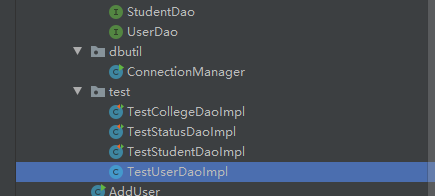
(1)编写方法testFindById()

运行结果:
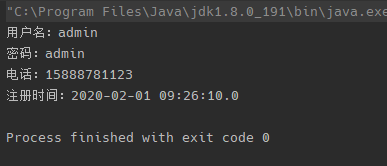
(2)编写方法testLogin()

运行结果:
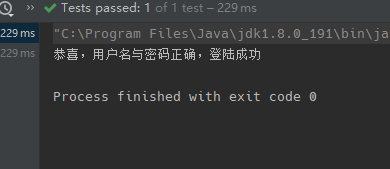
(3)编写测试方法testIsUsernameExisted()

运行结果:

(4)编写测试方法testInsert()

运行结果:

(5)编写测试方法testDeleteById()

运行结果如下:
由于输入的id已经被删除,所以结果会显示出记录删除失败,修改id即可删除成功

(6)编写testUpdate()方法
**
运行结果:

数据表结果:

(7)编写testFindAll()方法

运行结果:

总结
这次博客的内容,包括了两次课的任务,最近两次的实训任务都比较多,所以花费了较多时间,在完成这次任务的途中也出现了很多问题,大多时间是由于打字速度过快,单词出现拼写错误,影响了后面代码的运行,也花了很多时间改正前几次任务中的单词拼写问题,由此在以后编写层层相扣的项目时,一定要注意细节,一些细节问题可能会导致后面花很多时间去改正。在涉及数据库操作时,编写代码一定要与数据库中的字符类型相对应,基础一定要打好,后面才会更快完成任务。